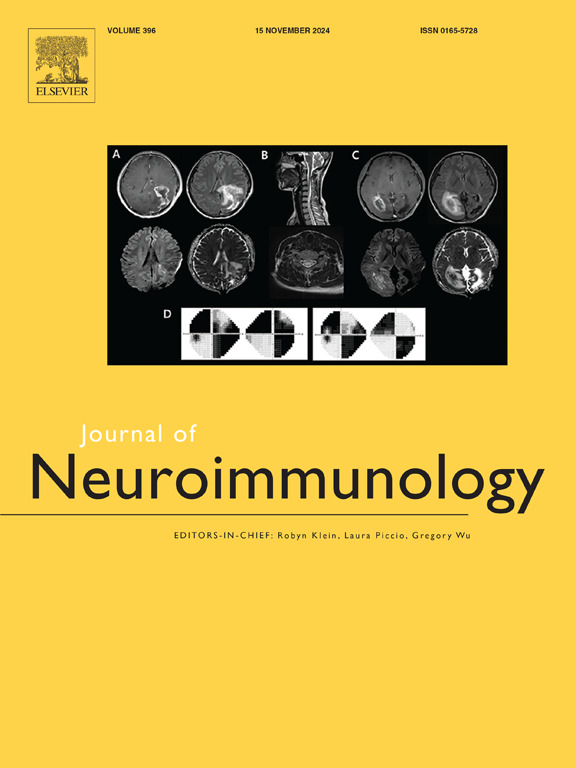Response of refractory residual ocular symptoms to efgartigimod in generalized myasthenia gravis: A real-world case series
IF 2.5
4区 医学
Q3 IMMUNOLOGY
引用次数: 0
Abstract
Objective
To evaluate the efficacy of efgartigimod (EFG) in treating residual ocular symptoms in myasthenia gravis (MG) patients with acetylcholine receptor antibodies (AChR-Ab).
Methods
Five MG patients with refractory residual ocular symptoms treated with EFG at Huashan Hospital were included. The demographic and clinical information was collected, and MG Activities of Daily Living (MG-ADL) scores and Quantitative Myasthenia Gravis (QMG) scores was elevated weekly during the 8-week follow up period. The time to reach minimal symptom expression (MSE) was also recorded.
Results
After a single cycle of EFG infusion, all five patients showed response in MG-ADL (≥2 points reduction), and three patients in QMG score (≥3 points reduction). The mean ± SD MG-ADL scores decreased significantly from 5.0 ± 1.0 at baseline to 1.8 ± 1.1 at weak 4 (p = 0.0027) and 1.8 ± 0.5 at weak 6 (p = 0.0027). The mean ± SD QMG score decreased from 5.8 ± 0.5 at baseline to 2.4 ± 1.7 at week 4 (p = 0.1357) and 1.0 ± 0.7 at week 6 (p = 0.0076). The proportions of patients reaching MSE at week 4, 6 and 8 were 20 % (1/5), 20 % (1/5), and 60 % (3/5), respectively.
Conclusions
AChR-Ab+ MG patients with residual and refractory ocular symptoms could benefit from EFG treatment, while the duration of efficacy varied in individuals.

广泛性重症肌无力患者对难治残余眼部症状的反应:真实世界的病例系列
目的评价依加替莫德(EFG)治疗伴有乙酰胆碱受体抗体(AChR-Ab)的重症肌无力(MG)患者眼部残留症状的疗效。方法对5例在华山医院接受EFG治疗的伴有难治性眼部残余症状的MG患者进行分析。收集人口统计学和临床信息,在8周的随访期间,MG日常生活活动(MG- adl)评分和定量重症肌无力(QMG)评分每周升高。同时记录达到最小症状表达(MSE)的时间。结果经单周期EFG输注后,5例患者MG-ADL均有缓解(降低≥2分),3例患者QMG评分降低(降低≥3分)。平均±SD MG-ADL评分从基线时的5.0±1.0下降到弱4时的1.8±1.1 (p = 0.0027)和弱6时的1.8±0.5 (p = 0.0027)。QMG的平均±SD评分从基线时的5.8±0.5下降到第4周时的2.4±1.7 (p = 0.1357)和第6周时的1.0±0.7 (p = 0.0076)。患者在第4周、第6周和第8周达到MSE的比例分别为20%(1/5)、20%(1/5)和60%(3/5)。结论伴有残留和难治性眼部症状的achr - ab + MG患者可从EFG治疗中获益,但疗效持续时间因人而异。
本文章由计算机程序翻译,如有差异,请以英文原文为准。
求助全文
约1分钟内获得全文
求助全文
来源期刊

Journal of neuroimmunology
医学-免疫学
CiteScore
6.10
自引率
3.00%
发文量
154
审稿时长
37 days
期刊介绍:
The Journal of Neuroimmunology affords a forum for the publication of works applying immunologic methodology to the furtherance of the neurological sciences. Studies on all branches of the neurosciences, particularly fundamental and applied neurobiology, neurology, neuropathology, neurochemistry, neurovirology, neuroendocrinology, neuromuscular research, neuropharmacology and psychology, which involve either immunologic methodology (e.g. immunocytochemistry) or fundamental immunology (e.g. antibody and lymphocyte assays), are considered for publication.
 求助内容:
求助内容: 应助结果提醒方式:
应助结果提醒方式:


